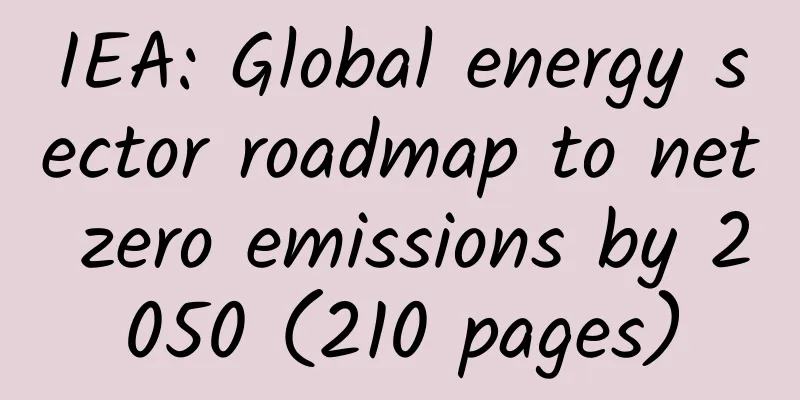IEA: Global energy sector roadmap to net zero emissions by 2050 (210 pages)

|
According to the Roadmap, near-zero emissions will be achieved by 2050, and renewable energy will become the dominant energy source. The energy sector relies mainly on renewable energy, rather than fossil fuels. In 2050, wind, solar, biomass, geothermal and hydropower will account for two-thirds of total energy supply. Solar will become the largest source of energy, accounting for one-fifth of total energy supply. By 2050, solar photovoltaic installed capacity will be 20 times the current level, and wind power installed capacity will be 11 times the current level. Near-zero emissions also mean a significant reduction in fossil fuel consumption, which will fall from nearly 4/5 of total energy supply today to just over 1/5 in 2050. Fossil fuels will still be used in 2050 in carbon-containing commodities (such as plastics), production facilities equipped with CCUS, and sectors that lack low-emission technologies. According to the Roadmap, electricity will account for nearly 50% of total energy consumption in 2050. Electricity will play a key role in various sectors such as transportation, construction, and industry. To achieve the above scenario, the global total power generation in 2050 needs to reach more than 2.5 times the current level. At the same time, from now on, no final investment decision will be made on the construction of coal-fired power plants without emission reduction facilities (the least efficient coal-fired), all inefficient coal-fired power plants will be eliminated before 2030, and the remaining coal-fired power plants still in use will be transformed before 2040. By 2050, nearly 90% of electricity generation will come from renewable energy, with wind and solar photovoltaic power generation accounting for nearly 70% in total, and most of the rest coming from nuclear power. The Roadmap states that, globally, no new investment in fossil fuel supply should be made. No new oil and gas field development projects will be approved, and no new coal mine construction or extension projects will be approved, except for projects that have been committed before 2021. By 2050, demand for coal without emission reduction measures will account for only 1% of total energy consumption, a decrease of 98%; natural gas demand will fall to 1.75 trillion cubic meters, a decrease of 55%; and oil demand will fall to 24 million barrels per day, a decrease of 75% from about 90 million barrels per day in 2020. According to the path requirements of the Roadmap, solar and wind power generation will be rapidly expanded in the next 10 years: by 2030, 630 GW of new solar photovoltaic capacity and 390 GW of new wind power capacity will be installed each year, a growth rate four times the record level in 2020. In addition, hydropower and nuclear power, as the two largest sources of low-carbon electricity in the world today, also provide the necessary foundation for the low-carbon transformation of electricity. The PDF version will be shared on 199IT Knowledge Planet, just scan the QR code below! |
>>: Interactive technology in urgent need of change: Five sins of TV remote control
Recommend
The construction of market operation system for start-ups: pay attention to these 7 points!
As long as a startup company is not incubated by ...
4 key points of e-commerce product operation
In addition to the North Star Indicator, which is...
Baidu bidding promotion - keyword lowest CPC bidding strategy
The core of measuring search marketing is ROI. CP...
Timely warning and comprehensive deployment in many places to actively respond to blizzards and cold waves
Affected by the cold wave, the temperature in the...
Review of Duozhaoyu APP activity planning and promotion
The article is a review of the activity planning ...
Qualcomm & IHS Markit: 5G Economic Report
The latest research results show that global 5G i...
Practical information: Zhihu promotion and traffic diversion only need to do these 3 things
Zhihu not only has a large amount of traffic, but...
How big is the space for content e-commerce that directly realizes the value of the knowledge economy?
At present, with the popularity of " Fenda &...
Deployment of mobile terminal chips to promote the independent development of 4G industry
Mobile communications is a strategic emerging ind...
How to achieve effective drainage? Share 2 strategies!
There are only two truly effective traffic-genera...
Sichuan Hanyuan 4.8 magnitude earthquake! Transfer! An effective guide to escape and self-rescue in case of an earthquake
According to the official measurement of the Chin...
World Alzheimer's Day丨Keep the "eraser of memory" away from us
September 21, 2022 The 29th World Alzheimer's...
Will Internet TV make a comeback in 2015?
After more than half a year of chaos, the Interne...
Google launches ARCore, an augmented reality SDK, to compete with Apple's ARKit
[[201618]] On August 30, Google announced the lau...
Tumor "natural killer"! New progress in NK cell research at USTC
Natural Killer (NK) cells are important members o...









